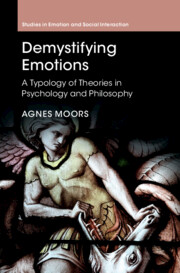Book contents
- Demystifying Emotions
- Studies in Emotion and Social Interaction
- Demystifying Emotions
- Copyright page
- Contents
- Figures
- Tables
- Boxes
- Preface
- Acknowledgment
- Abbreviations
- Part I Introduction
- Chapter 1 Theory Development and Concepts
- Chapter 2 Demarcation-Explanation Cycle Applied to Emotion Theories
- Part II Emotion Theories One by One
- Part III Conclusion
- References
- Index
- Titles Published in the Second Series (continued from page ii)
Chapter 2 - Demarcation-Explanation Cycle Applied to Emotion Theories
from Part I - Introduction
Published online by Cambridge University Press: 11 August 2022
- Demystifying Emotions
- Studies in Emotion and Social Interaction
- Demystifying Emotions
- Copyright page
- Contents
- Figures
- Tables
- Boxes
- Preface
- Acknowledgment
- Abbreviations
- Part I Introduction
- Chapter 1 Theory Development and Concepts
- Chapter 2 Demarcation-Explanation Cycle Applied to Emotion Theories
- Part II Emotion Theories One by One
- Part III Conclusion
- References
- Index
- Titles Published in the Second Series (continued from page ii)
Summary
This chapter applies the demarcation-explanation cycle to emotion theories. In Stage 1, theories propose working definitions of emotion listing (a) properties of emotions (intensional format) and/or (b) prototypical emotions (divisio format). Typical and apparent properties of emotions are that they have ontogenetic and phylogenetic continuity, are caused by important events, have mental aspects (Intentionality, phenomenality) and bodily aspects (somatic responses, subtle and coarse motor responses), and are characterized by heat (valence, intensity), automaticity, control precedence, and irrationality. Prototypical emotions are fear, anger, sadness, joy, and so on. In Stage 2, theories offer constitutive and/or causal-mechanistic explanations for emotions. In Stage 3, the explanations are validated in empirical research. In Stage 4, they form the basis for the eventual scientific definitions of emotions that allows (a) demarcating the set of emotions from other sets (intensional format) and (b) partitioning the set of emotions into subsets (divisio format). The demarcation-explanation cycle forms the basis for a novel typology of emotion theories in which the theories are placed on several axes. The axes correspond to questions that arise at various stages in the demarcation-explanation cycle and the positions of theories on these axes correspond to the answers they formulate to these questions.
Keywords
- Type
- Chapter
- Information
- Demystifying EmotionsA Typology of Theories in Psychology and Philosophy, pp. 32 - 86Publisher: Cambridge University PressPrint publication year: 2022

